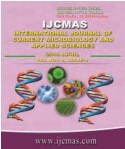


 National Academy of Agricultural Sciences (NAAS)
National Academy of Agricultural Sciences (NAAS)

|
PRINT ISSN : 2319-7692
Online ISSN : 2319-7706 Issues : 12 per year Publisher : Excellent Publishers Email : editorijcmas@gmail.com / submit@ijcmas.com Editor-in-chief: Dr.M.Prakash Index Copernicus ICV 2018: 95.39 NAAS RATING 2020: 5.38 |
Sesame (Sesamum indicum L.) is one of the most ancient oil seed crop cultivated in tropical and sub-tropical countries. Irrespective of the agro-climate conditions, sesame is liable to be infected by various pathogenic fungi. Among the fungal diseases, stem and root rot of sesame caused by Macrophomina phaseolina affects severely at all stages of crop growth. Macrophomina phaseolina is a diverse, omnipresent soil borne pathogen. The pathogen survives as sclerotia in the soil and in host tissue for varying periods. Two consecutive summer season trials of 2017 and 2018 were conducted at Agricultural Experimental Farm, Institute of Agricultural Science, University of Calcutta, Baruipur, South 24 Parganas. Integrated management of stem and root rot disease (M. phaseolina) of sesame was conducted with seven treatments. The results revealed that minimum stem and root rot incidence (9.5%) and maximum yield (557 kg/ha) with C:B ratio 2.40 in 2017, stem and root rot incidence (10.5%) and Maximum yield (545 kg/ha) with C:B ratio 2.33 in 2018 were recorded in the treatment of T6 (Seed treatment with carbendazim @ 2 g/kg + soil drenching with carbendazim @ 1 g/ l).
 |
 |
 |
 |
 |